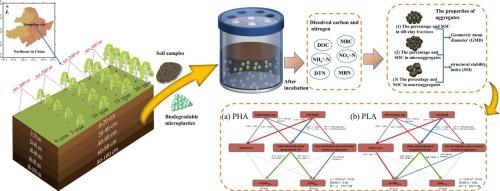The impact of biodegradable microplastics on soil aggregate stability across different afforestation ages and soil depths in poplar shelterbelts
IF 7.1
2区 环境科学与生态学
Q1 ENGINEERING, ENVIRONMENTAL
引用次数: 0
Abstract
Soil aggregates play a critical role in maintaining the ecological stability of forest ecosystems. Due to the widespread application of biodegradable plastics in farmland, the soil of shelterbelts planted on abandoned farmland may become a site for the accumulation of biodegradable microplastics (BMPs). BMPs may present ecological risks to shelterbelt ecosystems by influencing the stability of soil aggregates across various afforestation ages and soil depths. However, this potential impact remains insufficiently investigated. Herein, a 60-day incubation experiment was conducted to investigate the effects of BMPs (polyhydroxyalkanoates (PHA) and polylactic acid (PLA)) on aggregate size distribution, aggregate-associated carbon, and aggregate stability across various afforestation ages (0, 5, 10, 15, and 20 years) and soil depths (0–20, 20–40, 40–60, 60–80, and 80–100 cm). The results indicated that PHA led to a decrease in the microaggregate content (4.94–22.22%), while increasing the macroaggregate content (43.64–1167.04%) and the geometric mean diameter (GMD) of soil aggregates (7.39–49.05%) across all soil samples. Generally, PLA reduced the content of microaggregates (1.95–7.61%) while increasing that of macroaggregates (28.47–216.75%) and the GMD (10.23–29.07%) in the soils of 0-year-old shelterbelts. Furthermore, the extent of improvement in GMD (ΔGMDPHA) and structural stability index (SSI) (ΔSSIPHA) induced by PHA exhibited a positive correlation with increasing soil depth (P < 0.05). Since neither PHA nor PLA reduced the stability of soil aggregates across all afforestation ages and soil depths, the BMPs pose no ecological risk to shelterbelts based on soil aggregates in the short term.

可生物降解微塑料对不同造林年限和土壤深度杨树防护林土壤团聚体稳定性的影响
土壤团聚体对维持森林生态系统的生态稳定起着至关重要的作用。由于生物降解塑料在农田中的广泛应用,废弃农田上种植的防护林土壤可能成为生物降解微塑料(BMPs)积累的场所。bmp可能通过影响不同造林年龄和土壤深度的土壤团聚体的稳定性而给林带生态系统带来生态风险。然而,这一潜在影响仍未得到充分调查。通过60天的培养试验,研究了不同造林年龄(0、5、10、15和20年)和土壤深度(0 - 20、20 - 40、40-60、60-80和80-100 cm)下,bmp(聚羟基烷酸酯(PHA)和聚乳酸(PLA)对团聚体粒径分布、团聚体相关碳和团聚体稳定性的影响。结果表明,PHA降低了土壤微团聚体含量(4.94 ~ 22.22%),增加了土壤大团聚体含量(43.64 ~ 1167.04%)和土壤团聚体几何平均直径(GMD)(7.39 ~ 49.05%)。总体而言,PLA降低了0年林龄防护林土壤的微团聚体含量(1.95 ~ 7.61%),增加了大团聚体含量(28.47 ~ 216.75%)和GMD含量(10.23 ~ 29.07%)。此外,PHA对土壤GMD (ΔGMDPHA)和结构稳定指数(SSI) (ΔSSIPHA)的改善程度与土壤深度的增加呈正相关(P < 0.05)。由于PHA和PLA在所有造林年龄和土壤深度都没有降低土壤团聚体的稳定性,因此bmp在短期内不会对基于土壤团聚体的防护林造成生态风险。
本文章由计算机程序翻译,如有差异,请以英文原文为准。
求助全文
约1分钟内获得全文
求助全文
来源期刊

Waste management
环境科学-工程:环境
CiteScore
15.60
自引率
6.20%
发文量
492
审稿时长
39 days
期刊介绍:
Waste Management is devoted to the presentation and discussion of information on solid wastes,it covers the entire lifecycle of solid. wastes.
Scope:
Addresses solid wastes in both industrialized and economically developing countries
Covers various types of solid wastes, including:
Municipal (e.g., residential, institutional, commercial, light industrial)
Agricultural
Special (e.g., C and D, healthcare, household hazardous wastes, sewage sludge)
 求助内容:
求助内容: 应助结果提醒方式:
应助结果提醒方式:


